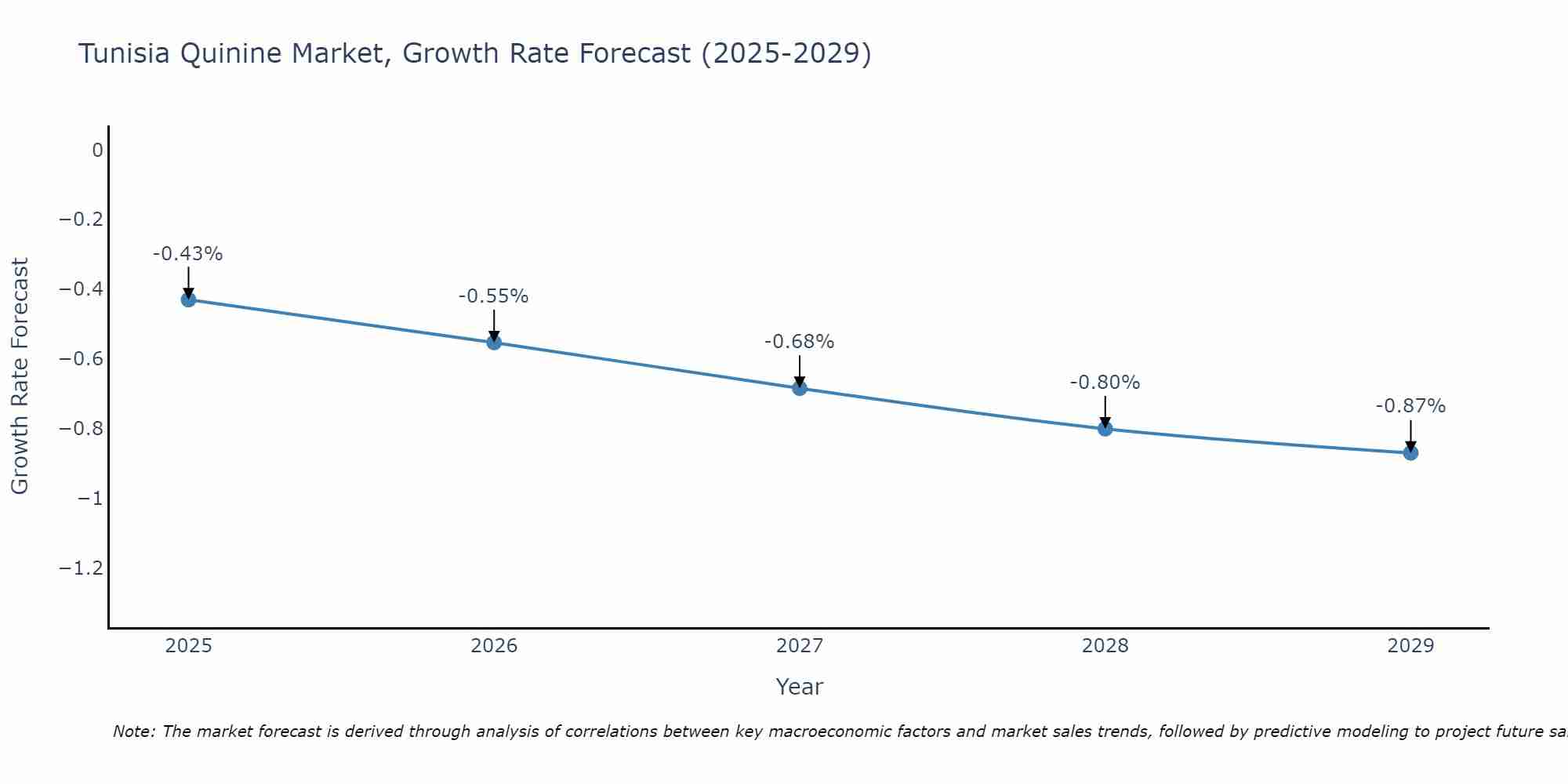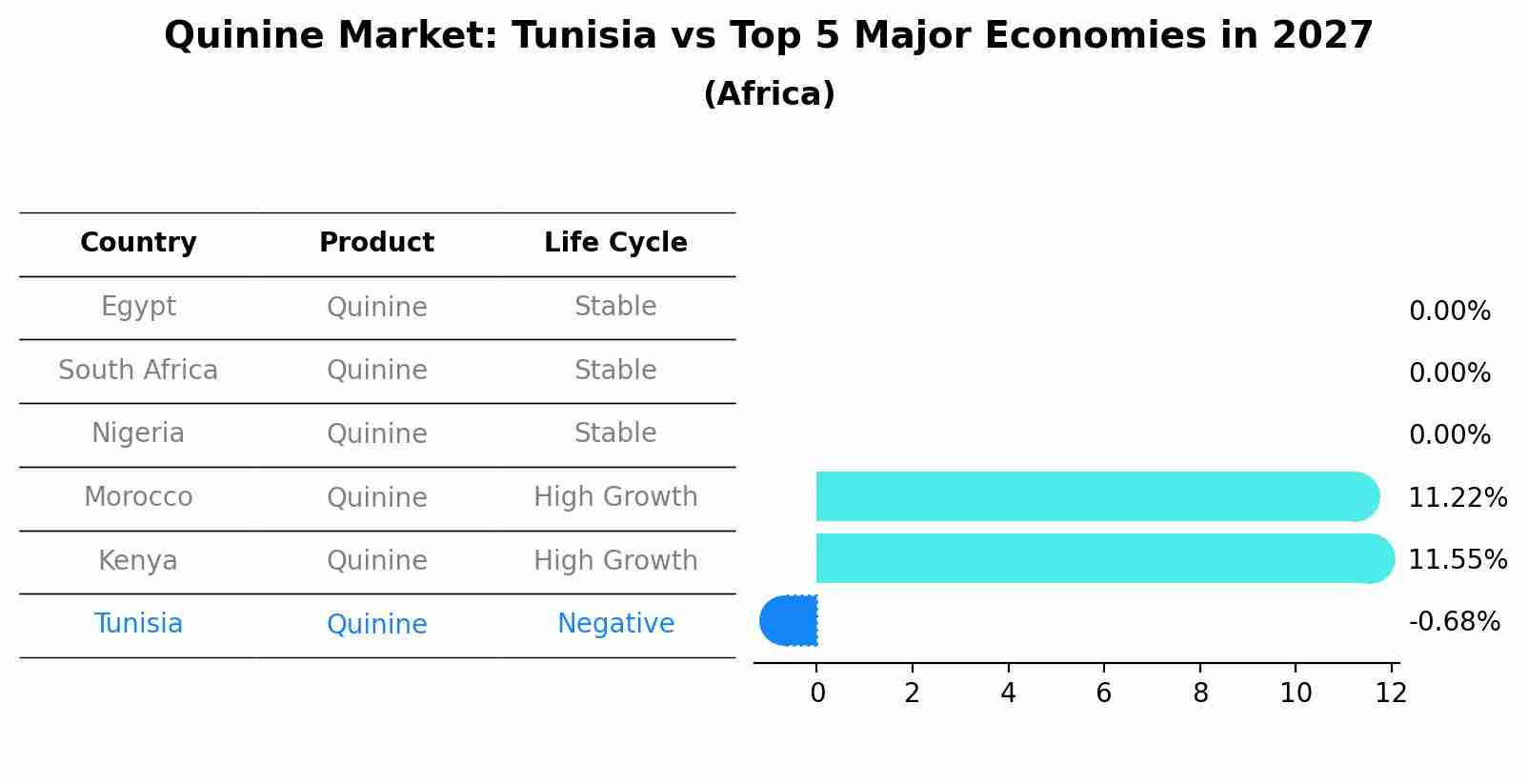Tunisia Quinine Market (2025-2031) Outlook | Value, Growth, Companies, Revenue, Analysis, Size, Trends, Industry, Forecast & Share
| Product Code: ETC343734 | Publication Date: Aug 2022 | Updated Date: Aug 2025 | Product Type: Market Research Report | |
| Publisher: 6Wresearch | Author: Shubham Padhi | No. of Pages: 75 | No. of Figures: 35 | No. of Tables: 20 |
Tunisia Quinine Market Size Growth Rate
The Tunisia Quinine Market may undergo a gradual slowdown in growth rates between 2025 and 2029. Although the growth rate starts strong at -0.43% in 2025, it steadily loses momentum, ending at -0.87% by 2029.

Quinine Market: Tunisia vs Top 5 Major Economies in 2027 (Africa)
By 2027, the Quinine market in Tunisia is anticipated to reach a growth rate of -0.68%, as part of an increasingly competitive Africa region, where Egypt remains at the forefront, supported by South Africa, Nigeria, Morocco and Kenya, driving innovations and market adoption across sectors.

Tunisia Quinine Market Overview
The Tunisia quinine market is developing due to the demand for quinine in the pharmaceutical and beverage industries. Quinine, primarily known for its use in treating malaria, is also a key ingredient in tonic water and other beverages. The market growth is driven by the prevalence of malaria in certain regions, increasing demand for anti-malarial drugs, and the popularity of quinine-based beverages. Additionally, research and development activities focused on expanding the therapeutic applications of quinine contribute to the market`s growth.
Drivers of the market
In Tunisia, the Quinine market is driven by its widespread use in pharmaceuticals for treating malaria and other infectious diseases. Quinine`s effectiveness in combating malaria parasites, coupled with increasing healthcare investments and government initiatives to control malaria, fuels market demand. Rising incidence of malaria in tropical regions sustains the need for quinine-based treatments, supporting market growth.
Challenges of the market
The Tunisia Quinine market encounters challenges related to sustainability of supply sources, as well as regulatory constraints on extraction and distribution. Fluctuations in demand from pharmaceutical and beverage sectors also influence market dynamics.
Government Policy of the market
The Tunisian government oversees the quinine market with stringent regulations on production, distribution, and medical use to ensure safety and efficacy standards. Policies prioritize quality control measures in pharmaceutical manufacturing and importation to safeguard public health. Collaboration with international health organizations facilitates access to affordable quinine-based treatments while promoting research into alternative therapeutic options.
Key Highlights of the Report:
- Tunisia Quinine Market Outlook
- Market Size of Tunisia Quinine Market, 2024
- Forecast of Tunisia Quinine Market, 2031
- Historical Data and Forecast of Tunisia Quinine Revenues & Volume for the Period 2021-2031
- Tunisia Quinine Market Trend Evolution
- Tunisia Quinine Market Drivers and Challenges
- Tunisia Quinine Price Trends
- Tunisia Quinine Porter's Five Forces
- Tunisia Quinine Industry Life Cycle
- Historical Data and Forecast of Tunisia Quinine Market Revenues & Volume By Mode of Administration for the Period 2021-2031
- Historical Data and Forecast of Tunisia Quinine Market Revenues & Volume By Oral Administration for the Period 2021-2031
- Historical Data and Forecast of Tunisia Quinine Market Revenues & Volume By Intravenous Administration for the Period 2021-2031
- Historical Data and Forecast of Tunisia Quinine Market Revenues & Volume By Intramuscular Administration for the Period 2021-2031
- Historical Data and Forecast of Tunisia Quinine Market Revenues & Volume By Others for the Period 2021-2031
- Historical Data and Forecast of Tunisia Quinine Market Revenues & Volume By Application for the Period 2021-2031
- Historical Data and Forecast of Tunisia Quinine Market Revenues & Volume By Antimalarial for the Period 2021-2031
- Historical Data and Forecast of Tunisia Quinine Market Revenues & Volume By Antipyretic for the Period 2021-2031
- Historical Data and Forecast of Tunisia Quinine Market Revenues & Volume By Others for the Period 2021-2031
- Historical Data and Forecast of Tunisia Quinine Market Revenues & Volume By End-user for the Period 2021-2031
- Historical Data and Forecast of Tunisia Quinine Market Revenues & Volume By Hospitals for the Period 2021-2031
- Historical Data and Forecast of Tunisia Quinine Market Revenues & Volume By Clinics for the Period 2021-2031
- Historical Data and Forecast of Tunisia Quinine Market Revenues & Volume By Ambulatory Surgical Centers for the Period 2021-2031
- Historical Data and Forecast of Tunisia Quinine Market Revenues & Volume By Others for the Period 2021-2031
- Tunisia Quinine Import Export Trade Statistics
- Market Opportunity Assessment By Mode of Administration
- Market Opportunity Assessment By Application
- Market Opportunity Assessment By End-user
- Tunisia Quinine Top Companies Market Share
- Tunisia Quinine Competitive Benchmarking By Technical and Operational Parameters
- Tunisia Quinine Company Profiles
- Tunisia Quinine Key Strategic Recommendations
Frequently Asked Questions About the Market Study (FAQs):
1 Executive Summary |
2 Introduction |
2.1 Key Highlights of the Report |
2.2 Report Description |
2.3 Market Scope & Segmentation |
2.4 Research Methodology |
2.5 Assumptions |
3 Tunisia Quinine Market Overview |
3.1 Tunisia Country Macro Economic Indicators |
3.2 Tunisia Quinine Market Revenues & Volume, 2021 & 2031F |
3.3 Tunisia Quinine Market - Industry Life Cycle |
3.4 Tunisia Quinine Market - Porter's Five Forces |
3.5 Tunisia Quinine Market Revenues & Volume Share, By Mode of Administration, 2021 & 2031F |
3.6 Tunisia Quinine Market Revenues & Volume Share, By Application, 2021 & 2031F |
3.7 Tunisia Quinine Market Revenues & Volume Share, By End-user, 2021 & 2031F |
4 Tunisia Quinine Market Dynamics |
4.1 Impact Analysis |
4.2 Market Drivers |
4.2.1 Growing awareness about the health benefits of quinine and its medicinal properties in Tunisia |
4.2.2 Increasing demand for natural and herbal remedies in the healthcare sector |
4.2.3 Rise in disposable income leading to higher spending on healthcare products in Tunisia |
4.3 Market Restraints |
4.3.1 Stringent regulations and quality standards for quinine production and distribution in Tunisia |
4.3.2 Potential side effects and health risks associated with quinine consumption |
4.3.3 Competition from alternative medicinal products in the Tunisian market |
5 Tunisia Quinine Market Trends |
6 Tunisia Quinine Market, By Types |
6.1 Tunisia Quinine Market, By Mode of Administration |
6.1.1 Overview and Analysis |
6.1.2 Tunisia Quinine Market Revenues & Volume, By Mode of Administration, 2021-2031F |
6.1.3 Tunisia Quinine Market Revenues & Volume, By Oral Administration, 2021-2031F |
6.1.4 Tunisia Quinine Market Revenues & Volume, By Intravenous Administration, 2021-2031F |
6.1.5 Tunisia Quinine Market Revenues & Volume, By Intramuscular Administration, 2021-2031F |
6.1.6 Tunisia Quinine Market Revenues & Volume, By Others, 2021-2031F |
6.2 Tunisia Quinine Market, By Application |
6.2.1 Overview and Analysis |
6.2.2 Tunisia Quinine Market Revenues & Volume, By Antimalarial, 2021-2031F |
6.2.3 Tunisia Quinine Market Revenues & Volume, By Antipyretic, 2021-2031F |
6.2.4 Tunisia Quinine Market Revenues & Volume, By Others, 2021-2031F |
6.3 Tunisia Quinine Market, By End-user |
6.3.1 Overview and Analysis |
6.3.2 Tunisia Quinine Market Revenues & Volume, By Hospitals, 2021-2031F |
6.3.3 Tunisia Quinine Market Revenues & Volume, By Clinics, 2021-2031F |
6.3.4 Tunisia Quinine Market Revenues & Volume, By Ambulatory Surgical Centers, 2021-2031F |
6.3.5 Tunisia Quinine Market Revenues & Volume, By Others, 2021-2031F |
7 Tunisia Quinine Market Import-Export Trade Statistics |
7.1 Tunisia Quinine Market Export to Major Countries |
7.2 Tunisia Quinine Market Imports from Major Countries |
8 Tunisia Quinine Market Key Performance Indicators |
8.1 Consumer satisfaction and repeat purchase rate for quinine products in Tunisia |
8.2 Number of new product launches and innovations in the Tunisian quinine market |
8.3 Level of investment in research and development for quinine-based products in Tunisia |
9 Tunisia Quinine Market - Opportunity Assessment |
9.1 Tunisia Quinine Market Opportunity Assessment, By Mode of Administration, 2021 & 2031F |
9.2 Tunisia Quinine Market Opportunity Assessment, By Application, 2021 & 2031F |
9.3 Tunisia Quinine Market Opportunity Assessment, By End-user, 2021 & 2031F |
10 Tunisia Quinine Market - Competitive Landscape |
10.1 Tunisia Quinine Market Revenue Share, By Companies, 2024 |
10.2 Tunisia Quinine Market Competitive Benchmarking, By Operating and Technical Parameters |
11 Company Profiles |
12 Recommendations |
13 Disclaimer |
- Single User License$ 1,995
- Department License$ 2,400
- Site License$ 3,120
- Global License$ 3,795
Search
Thought Leadership and Analyst Meet
Our Clients
Related Reports
- Canada Oil and Gas Market (2026-2032) | Share, Segmentation, Value, Industry, Trends, Forecast, Analysis, Size & Revenue, Growth, Competitive Landscape, Outlook, Companies
- Germany Breakfast Food Market (2026-2032) | Industry, Share, Growth, Size, Companies, Value, Analysis, Revenue, Trends, Forecast & Outlook
- Australia Briquette Market (2025-2031) | Growth, Size, Revenue, Forecast, Analysis, Trends, Value, Share, Industry & Companies
- Vietnam System Integrator Market (2025-2031) | Size, Companies, Analysis, Industry, Value, Forecast, Growth, Trends, Revenue & Share
- ASEAN and Thailand Brain Health Supplements Market (2025-2031) | Strategy, Consumer Insights, Analysis, Investment Trends, Opportunities, Growth, Size, Share, Industry, Revenue, Segments, Value, Segmentation, Supply, Forecast, Restraints, Outlook, Competition, Drivers, Trends, Demand, Pricing Analysis, Competitive, Strategic Insights, Companies, Challenges
- ASEAN Bearings Market (2025-2031) | Strategy, Consumer Insights, Analysis, Investment Trends, Opportunities, Growth, Size, Share, Industry, Revenue, Segments, Value, Segmentation, Supply, Forecast, Restraints, Outlook, Competition, Drivers, Trends, Demand, Pricing Analysis, Competitive, Strategic Insights, Companies, Challenges
- Europe Flooring Market (2025-2031) | Outlook, Share, Industry, Trends, Forecast, Companies, Revenue, Size, Analysis, Growth & Value
- Saudi Arabia Manlift Market (2025-2031) | Outlook, Size, Growth, Trends, Companies, Industry, Revenue, Value, Share, Forecast & Analysis
- Uganda Excavator, Crane, and Wheel Loaders Market (2025-2031) | Strategy, Consumer Insights, Analysis, Investment Trends, Opportunities, Growth, Size, Share, Industry, Revenue, Segments, Value, Segmentation, Supply, Forecast, Restraints, Outlook, Competition, Drivers, Trends, Demand, Pricing Analysis, Competitive, Strategic Insights, Companies, Challenges
- Rwanda Excavator, Crane, and Wheel Loaders Market (2025-2031) | Strategy, Consumer Insights, Analysis, Investment Trends, Opportunities, Growth, Size, Share, Industry, Revenue, Segments, Value, Segmentation, Supply, Forecast, Restraints, Outlook, Competition, Drivers, Trends, Demand, Pricing Analysis, Competitive, Strategic Insights, Companies, Challenges
Industry Events and Analyst Meet
Whitepaper
- Middle East & Africa Commercial Security Market Click here to view more.
- Middle East & Africa Fire Safety Systems & Equipment Market Click here to view more.
- GCC Drone Market Click here to view more.
- Middle East Lighting Fixture Market Click here to view more.
- GCC Physical & Perimeter Security Market Click here to view more.
6WResearch In News
- Doha a strategic location for EV manufacturing hub: IPA Qatar
- Demand for luxury TVs surging in the GCC, says Samsung
- Empowering Growth: The Thriving Journey of Bangladesh’s Cable Industry
- Demand for luxury TVs surging in the GCC, says Samsung
- Video call with a traditional healer? Once unthinkable, it’s now common in South Africa
- Intelligent Buildings To Smooth GCC’s Path To Net Zero


















